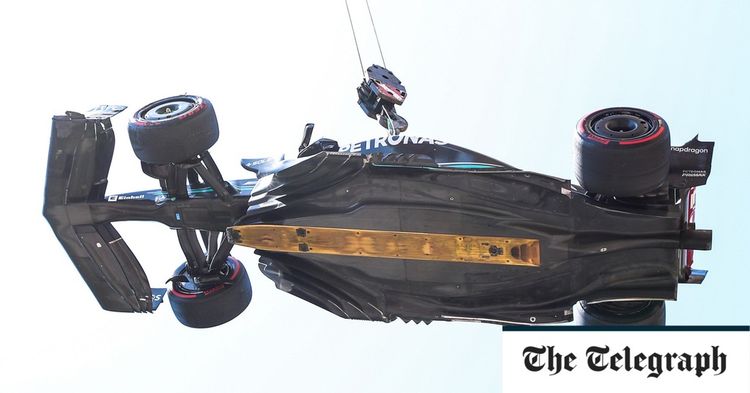Lewis Hamilton's US GP disqualification: Why his car's wooden plank broke rules

Lewis Hamilton's satisfying second place and impressive performance of the season turned sour when officials determined that his car's equipment violated the rules, leading to his disqualification.
The United States Grand Prix that took place on Sunday resulted in Charles Leclerc from Ferrari being disqualified due to the same violation. The team from Telegraph Sport analyzed and explained the situation.
Why Were Hamilton And Leclerc Disqualified?
The two drivers were penalized for having worn-out underfloor planks that are used to prevent teams from driving their cars too low. The depth of the newly-installed floors on both Hamilton's Mercedes and Leclerc's Ferrari was found to be beyond the acceptable limit, which specifies that the plank or skid block must not have a wear thickness of less than 9mm. After the race, four cars were randomly selected for inspection. Verstappen's Red Bull and Norris' McLaren were both cleared of any issues during the scrutineering checks.
Ron Meadows, the Director of Sport at Mercedes, together with Andrew Shovlin, the Director of Trackside Engineering, and Richard Lane, the Reliability Chief, were called upon to defend Hamilton's position with the FIA's team of four stewards, among whom was Derek Warwick, a former British driver.
The FIA released a statement stating that during the hearing, the team admitted that the measurement conducted by the FIA Technical Team was accurate. They also mentioned that the excessive wear on the skid pads could be due to the track's unevenness and the short amount of time to prepare and examine the car before the race, as the Saturday race was held on a tighter schedule.
The officials have observed that it is the responsibility of the participant to make certain that the vehicle adheres to the rules throughout the entire competition.
The FIA has declared that in this specific instance, the back end of the car in the designated area, as mentioned by the technical delegate's report, was not within the limits detailed in Article 3.5.9 e) of the FIA Formula One Technical Regulations, even when taking wear into account. As a result, the usual penalty for breaking the technical regulations will be enforced.
What's The Plank Underneath Your Car For?
Following the accidents of Roland Ratzenberger and Ayrton Senna, a new safety measure was put in place at the 1994 German Grand Prix. Cars were required to have a 10mm thick wooden plank attached underneath them to increase their height off the ground and reduce the amount of downforce generated by the underfloor. Skid blocks made of wood composite were also introduced for Formula Two and Formula Three races. These blocks are rectangular and have a uniform shape to maintain a specific minimum distance from the ground.
Lately, the FIA has required manufacturers to add metal pieces to the blocks in order to create sparks when they hit the ground. The guidelines set by the FIA for Formula One state that there must be a rectangular skid block installed under the center of the car. Typically, this block is made from a special material known as Jabroc, which is made from beechwood and created through a composite process. This material doesn't impede the flow of air beneath the vehicle.
"Benefits Of Illegal Plank For Hamilton And Leclerc?"
When driving at lower speeds, the car can experience an increase in downforce through the ground effect. However, it is not possible to determine if this advantage is the result of tire wear.
According to Gary Anderson, sports columnist for the Telegraph, it's misleading to claim that Hamilton's strongest performance of the year was due to the wear of the plank.
In different words, he expressed that the wear on the plank didn't seem to affect Mercedes' performance much. The most important thing is that ground effect cars work better when they're close to the ground, but if they get too close, hitting the ground can harm their performance.
On Sunday, the level of damage to the plank was very important. This damage was much worse at the start of the race because the car had more fuel and was heavier. However, by the end of the race, the plank wear was not as bad. During the final part of the race, the Mercedes was performing really well and the plank was not experiencing much wear and tear. All the damage to the plank had happened earlier on in the race.
How Frequent Are Disqualifications For Plank Violations?
Only one month after the regulations were implemented, Michael Schumacher lost his chance to triumph in the Belgian Grand Prix in 1994 due to excessive wear of his Benetton's plank. As a consequence, his competitor Damon Hill achieved the victory for Williams.
It's uncommon for a Grand Prix participant to be disqualified due to technical issues. Nevertheless, it happened in 2021 when Sebastian Vettel lost his second place ranking in Hungary. This was due to his vehicle's inability to provide a fuel sample required after the race.
Earlier on, Racing Point filed a protest that resulted in the disqualification of Nico Hulkenberg and Daniel Ricciardo's points in the 2019 Japanese GP due to their utilization of banned driving aids.
It is believed that there hasn't been a plank wear disqualification incident since Jarno Trulli was disqualified from the 2001 US Grand Prix in Indianapolis. However, Jordan managed to successfully challenge the decision, resulting in Trulli's exclusion being overturned.



































































